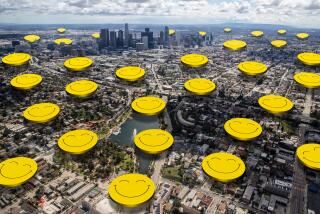The Concrete Grandeur of Southland’s Monuments
I’ll never forget the first time I saw--or rather experienced--the Zocalo, the great public square in the heart of Mexico City. Nothing in my California childhood had prepared me for the exhilarating moment of entering this vast plaza in the center of the ancient capital.
Emerging from a narrow side street, I suddenly found myself swept into this enormous open space, feeling as if the sky had opened up. The scene seemed to spin with the river of cars circling the square surrounded by ornate colonial buildings.
It was my introduction as a teenager to the thrilling grandeur of public architecture and spaces. No place in San Jose had ever set my spirit soaring.
The Spaniards felt similar astonishment almost 500 years ago when they first entered the Aztec capital. Geronimo de Aguilar, a priest and interpreter, was awe-struck by the sight of the city’s “splendid monuments,” pyramids with temples on top.
“Glorious heights!” he later wrote. “How marvelous it was to gaze on them.”
Today, only one public place in Southern California comes close to provoking that same breathtaking sensation.
The freeway. Especially those fantastic new interchanges with their interlacing ramps and wonderful overcrossings reaching to the heavens in long, sweeping curves.
Normally, we zoom through these modern monuments to our mobility without taking notice of their aesthetic statement. From a passing car, they are poetry in motion.
People complained that L.A.’s millennium parties fizzled partly because we have no central civic centerpiece, like Mexico’s Zocalo, New York’s Times Square and Paris’ Eiffel Tower. Our real problem is that we can’t gather around the only public structures we have that rival world-class architecture for boldness and beauty.
So next millennium, I suggest we shut down the freeways and throw a party on the ramps and connector roads. Let revelers roam those soaring roadways to their 10-story peaks. Let there be salsa dancing on the diamond lanes. Let the masses gather underneath and gaze up at what they paid for with their taxes.
Then let the fireworks light up these concrete works of art. The world would never again say we don’t know how to party.
Public works, such as power plants and train stations, are “often incredible gems of beautiful work,” said Patricia Belton Oliver, a UCLA-trained architect at Art Center College of Design in Pasadena. They often become emblems of a city, with “civic pride embedded in those structures.”
Our freeways sustain that tradition.
Freeway structures provide the only break in our otherwise bleak and monotonous landscape. Seen from a distance, the astounding interchange at the Harbor and Century freeways looms on the horizon like a futuristic landmark, a dazzling Oz at the end of a winding road.
Even single, simple ramps have become things of beauty that enliven our impoverishing vistas. After endless rows of boxy buildings and drab billboards, an overcrossing will gently lift itself alongside the freeway, curve delicately to change direction, then make a sleek, angled pass overhead to complete its function with utmost grace.
Carpool lanes peel away like strips of ribbon. Octagonal columns dramatically flared at the top--like those in the 110 median south of downtown--line up like proportioned musclemen lifting heavy elevated lanes with ease. Beveled bridges swoop and circle overhead, creating a confluence of harmonious curves and elegant lines as you sail through.
In 1931, Lewis Mumford, renowned architecture critic for the New Yorker, praised the George Washington Bridge. Though sheer engineering, he noted, it marked high water in architecture, unmatched by any skyscraper.
The bridge conveyed not the “faintest feeling of weight,” Mumford wrote. He admired its sense of fluid ease, its nonchalance about its function.
He could have been describing our modern freeway bridges, suspended effortlessly all around us, at the 5 and the 55, or the 405 and the 105.
My friends think I’m crazy, but I’ve been known to make a second pass through a particularly pretty interchange. Sunday night, I spent 20 minutes circling my latest discovery, the new link between the 91 and 57 freeways in Anaheim. It’s a gorgeous work-in-progress, with sweeping car-pool lanes that arch gracefully toward each other then turn away, like perfect orbits that never touch.
I know what the Spaniards would say.
Marvelous heights indeed!
*
Agustin Gurza’s column appears Tuesday. Readers can reach Gurza at (714) 966-7712 or [email protected]
More to Read
Sign up for The Wild
We’ll help you find the best places to hike, bike and run, as well as the perfect silent spots for meditation and yoga.
You may occasionally receive promotional content from the Los Angeles Times.






